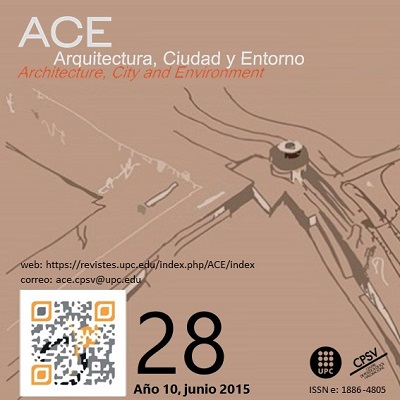Flat light guide - A sustainable and creative light source
DOI:
https://doi.org/10.5821/ace.10.28.2730Keywords:
ambience, architecture, lighting, flat light guidesAbstract
Light has always been used as a means of communication. As early as in the 4th century B.C. a hydraulic telegraph that was used in combination with fires has been developed by the Greeks. In 1821 Carl Friedrich Gauss invented heliotrope – an instrument that uses a mirror to reflect sunlight over great distances. Nowadays, light impulses travel on the principle of total reflection between materials of different density, inside round cross-section acrylic fibers—light guides—and are protected from inclement weather conditions and other disturbances from the surroundings. The result of such light "transportation" can be indirect – a transmission of data, or direct – a transmission of light with the purpose of illumination. Light that exits at the end of an optic fiber is usually formed as a point, as a line or, in our case, as a luminous surface. Light can also be intercepted on its way through a flat light guide, through a special surface treatment. Textures on the surface of sheets of acrylic glass form panels of either uniform or various brightness. Such panels can assume the role of the elements of an architectural luminous ambience. Transmission and reflectivity is also investigated, theoretical and practical, using light measurements on a physical model in order to show that luminous panels can also be used as floors/ceilings in multi-storey buildings in order to improve natural illumination and thus to reduce the cost of electrical lighting. Findings in the paper can bring useful information for architects, lighting designers and structural engineers.Downloads
Published
Issue
Section
License
| INTELECTUAL PROTECTION CRITERIA |
At this moment, it is count with the "Oficina Española de Patentes y Marcas", while global protection it is being processed by the World Intelectual Property Organization (OMPI/WIPO). Nevertheless the International Standard Serial Number Office (ISSN) has given the following numbers ISSN: 1886-4805 (electronic version) and 1887-7052 (paper version). All articles will be peer reviewed, using double blind reviewing. |
| COPYRIGHT |
The article contents and their comments are authors exclusive liability, and do not reflect necessarily the journal editor commitee's opinion. All ACE published works are subject to the following licence CC BY-NC-ND 3.0 ES http://creativecommons.org/licenses/by-nc-nd/3.0/es/ It implies that authors do not hold nor retain the copyright without restrictions but only those included in the licence. |


































